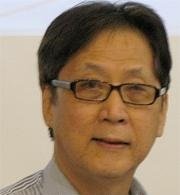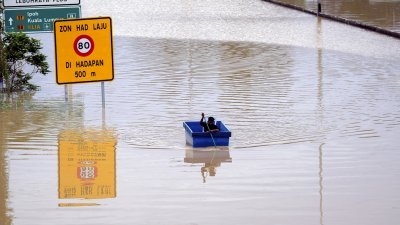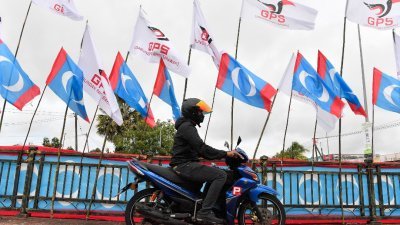美国国务卿安东尼布林肯紧随美国副总统哈里斯8月访问东盟后,于12月中出访东盟,这对东盟而言是一个危险信号。此次安东尼布林肯行程目的非常明确。
首先,美国此行并非“魅力攻势”外交,不是想要重建一个以前被美国关注,却在美国入侵阿富汗和中东地区后,被忽视的东盟地区关系。美国主要关注也不在于如西方媒体CNN和BBC宣传般,为本地区谋取繁荣、和平、民主和自由。
美国的意图是要将东盟国家拉拢进西方阵营。对于拜登总统来说,最重要的是打击美国“最主要的竞争对手”中国的影响力,对他来说,中国正在逐步超越美国。
为实现这一目标,美国已开始在广泛的战线上向中国施压——从政治、社会经济、技术到军事层面。在外交和军事领域美国领导著一个多元化的“反华联盟”,主要是由盎格鲁撒克逊国家组成,这包括北约、四方安全对话(QUAD由美国、日本、澳洲和印度4国组成)、五国联盟,以及最近的七国工业集团(G7),虽然后者没有依从美国所愿般。
美国最近一次围堵中国的举措就是成立印太安全联盟(AUKUS),一个由美国、澳洲和英国组成的联盟。
根据AUKUS协议,澳洲将获美国提供8艘核动力推进潜艇,这违反了澳洲早年签署具有约束力的1968年《不扩散核武器条约》 (NPT)。
同样,美国和英国也违反了1968年《不扩散核武器条约》的主要条款。 《不扩散核武器条约》第1条款指出:“每个有核武器的缔约国承诺不直接或间接向任何接受国转让核武器或其他核爆炸装置或对这种武器或爆炸装置的控制权”
对于澳洲获得核动力推进系统潜艇,东盟需要做出回应。如果美国和英国可以与澳洲共享核推进技术机密,我们又有何理由阻止中国和俄罗斯和其他国家分享核武器技术?
东盟如何应对新地缘政治变化,应是公众关注和讨论的课题。
东盟政策制定者应优先考虑的关键因素包括:东盟能否承受重返冷战时代的紧张局势和各方军事较量的影响和结果?
激化东盟军备竞赛
美国国务卿安东尼布林肯在访问印尼时,对美国印太战略发表声明时指出:“威胁不断改变,我们的安全战略也必须随之改变。为此,我们将依靠我们最大的力量:我们的联盟和伙伴关系”。“我们需采取更紧密地合作,将我们所有的国家权力工具——外交、军事、情报——与我们的盟友和合作伙伴分享”。
据安东尼布林肯,美国的战略将包括把美国和亚洲各国的国防工业连接起来,整合供应炼和合作技术创新。
这一战略不仅会增加东盟国家的军费开支,也会加强东盟军事工业复合体(MIC)力量。
所谓军事工业复合体(MIC)包括武器制造商、国防承包商、以及为各国武装部队提供军备者。军事工业复合体最重要组成部分,就是政府机构和从事军事采购的游说团体,政治家和商业利益集团。这部分公共支出普遍被认为容易滋生腐败。
东盟已经是军费开支增长最快的地区之一。更多的军事开支和投入任何形式的军备竞赛,只会对教育、住房、环境等急需优先发展事项的需求投资产生不利影响。这还可能为本区域带来核灾难。
同时,这会否也导致一些国家选边站,如果是的话,其又会带来什么影响?
目前,东盟国家在美国最新的反华战略上,没有协调一致的立场。一般来说,东盟国家都是中立的,或不表态。一些成员国指出,基于维护本区域和平、自由和中立,他们不会倾向任何一方。无论如何,东盟各国都坚定地致力于确保东南亚仍然是一个无核武器区域。
美国将中国视为敌人的战略,不仅会有外交政策后果。别忘了,中国是东盟最大贸易国伙伴囯,一旦东盟或任何成员国加入美国和盟国的反华,这将对经济造成附带的伤害,
对破坏东盟地区安全与稳定的美国和澳洲最新倡议,东盟应群起反对。尤其在美国及其盟友对中国施压,以压制中国的崛起时,本区域的决策者应有明确立场。
那东盟最优的选择是什么?
不选边立场
除了清楚明确地表明东盟反对任何旨在使本地区国家与中国发生冲突的战略外,东盟也应重申保持东南亚为无核武器和其他大规模杀伤性武器的地区承诺。东盟更需要继续与中国接触和沟通。
根据最近举行的中国-东盟建立对话关系30周年峰会,习近平主席告诉东盟10位领导人,北京不会“欺负”较小的区域邻国。他还表示,中国将不称霸,不以大欺小,愿与东盟合作消除外在“干涉”。
习近平表示,“中国过去是、现在是、将来也永远是东盟的好邻居、好朋友、好伙伴”。
这些话表明,中国至少在东盟地区,是致力于维持和平与互不干涉的非意识形态立场。如果能坚守,习近平的承诺应能为阻止美国将东盟带入西方新意识形态战场提供了基础。
过去,美国及其盟国在1950年代到70年代在越南、寮囯和柬埔寨与共产主义“祸害”的斗争,导致数百万人丧生并拖慢了至少一代人的发展。
东盟成员国不能再沦为世界大国博弈的战场。
林德宜《东盟如何在美中之间立足》原文:ASEAN: Between the US and China
The visit by US State Secretary Anthony Blinken, closely following that of US Vice President Kamala Harris to the region in August, should raise more than red flags in ASEAN countries. The objectives of the trips are very clear.
Firstly, they are not a “charm offensive” that wants to rebuild relations with a region previously ignored by US preoccupation with Afghanistan and the Middle East. Neither are they primarily concerned with helping secure prosperity, peace, democracy and freedom in the region as propagandized by western media channels such as CNN and BBC.
The US intention is to bring ASEAN nations into the orbit of the west. Foremost, for President Biden, is the need to bring down China which he sees as the “most serious competitor” of the US and which, to him, is poised “to eat our lunch”.
To achieve this, the United States has initiated pressure against China on a wide range of fronts - political, socio-economic, technological and military. In the diplomatic and military sphere the US has marshalled a diverse “coalition of the willing”, mainly Anglo Saxon countries, which now comprises NATO, the Quad, the Five Eyes Alliance, and more lately, though not successfully, G7.
AUKUS: The Anti-China Innovation
The most recent US initiative to encircle and confront China is AUKUS, a trilateral security pact.
By agreeing to receive eight nuclear-powered propulsion submarines under the AUKUS accord, Australia has breached its obligations under the binding 1968 Treaty of Non-Proliferation (NPT).
The US and UK have also breached the main provision in the 1968 NPT. Article 1 of the NPT reads: “Each nuclear-weapon State Party to the Treaty undertakes not to transfer to any recipient whatsoever nuclear weapons or other nuclear explosive devices or control over such weapons or explosive devices directly, or indirectly”
The much-hyped nuclear-powered propulsion for Australia’s new submarines needs a response from ASEAN. If the US and UK can share nuclear propulsion technology secrets with Australia, what is there to stop China and Russia from sharing nuclear weapons technology with other countries?
How Should ASEAN Respond
How ASEAN responds to the new geo-politics being played out should be a matter of public concern and discourse.
Key considerations that ASEAN’s policy makers should prioritize for deliberation include
Can the region afford a return to cold war tensions and the military impacts and outcomes?
The US Secretary of State, Blinken, in recent statements in Indonesia on the US Indo-Pacific plans, argued:
”Threats are evolving, our security approach has to evolve with them. To do that, we will lean on our greatest strength: our alliances and partnerships,” ministration’s Indo-Pacific plans.
“We’ll adopt a strategy that more closely weaves together all our instruments of national power – diplomacy, military, intelligence – with those of our allies and partners”.
According to him, The US strategy will include linking US and Asian defence industries, integrating supply chains and cooperating on technological innovation.
This strategy could see not only enhanced military expenditures but also the strengthening of the military industrial complex (MIC) in the ASEAN countries.
The MIC consists of arms-producing companies, defence contractors, and others buying and selling arms for the armed forces of countries. A vital part of the MIC are the government agencies and lobby groups of politicians and business interests engaged in the procurement of military items. This sector of public expenditure is generally acknowledged to be characterized by rampant corruption.
ASEAN is already one of the fastest growing military spending regions. Higher levels of military expenditure and participation in any form of the arms race will only adversely impact on the investment needs in education, housing, the environment and other urgent development priorities still lagging. It may also bring the possibility of a nuclear Armageddon right to the region’s doorstep.
Will it result in taking sides and if so what are the likely implications?
Presently, the Asean countries do not have a coordinated position on the new US anti-China strategy. Generally, they are neutral and non-committal. Some member states have cited, as a rationale for not taking sides, their policies on maintaining the region’s peace, freedom, and neutrality. However all are strongly committed to ensuring that Southeast Asia remains a zone free of nuclear weapons.
The US strategy in targeting China as the common enemy will not only have foreign policy consequences. China is ASEAN’s largest trading partner and there will be considerable collateral damage to the economic relationship should the Association or any member nation lend support to the US and allied anti-China bandwagon.
The undermining of ASEAN’s regional security and stability which comes with the latest US and Australian initiative should be opposed. This position should be made clear by the region’s policy makers as the US and its allies turn the screws on China to preempt or disrupt its rise on the world stage
What are the possible options that are best for ASEAN to pursue
Besides stating plainly and unambiguously the ASEAN position against any strategy that intends to draw the region’s countries into conflict with China, and reiteration of the ASEAN commitment to keep the Southeast Asian region free of nuclear and other weapons of mass destruction, ASEAN will need to continuously engage with China.
According to the most recent summit held to commemorate the 30th anniversary of the ASEAN-China Dialogue Relations, President Xi Jinping told the 10 leaders of the Association that Beijing would not "bully" its smaller regional neighbours. He also said that China would never seek hegemony nor take advantage of its size to coerce smaller countries, and would work with ASEAN to eliminate "interference". According to Xi, "China was, is, and will always be a good neighbour, good friend, and good partner of ASEAN".
These words indicate that China, at least in the ASEAN region, is committed to a non-ideological position of peace and non-interference. If upkept, Xi’s promise should provide the foundation to thwart any efforts by the United States to draw ASEAN into a new era of western inspired ideological war. The last attempt by the US and its allies from the 50s to 70s to fight against the ‘scourge’ of communism in Vietnam, Laos and Cambodia resulted in millions of lives lost and set back the region’s development by at least one generation. ASEAN’s member countries cannot afford to become ground zero for any form of contestation between the world’s leading powers.
要看最快最熱資訊,請來Follow我們 《東方日報》WhatsApp Channel.











.JPG/f70abce26524070f964a7a6719c17657.JPG)






